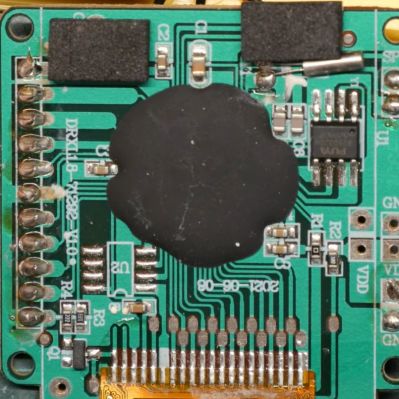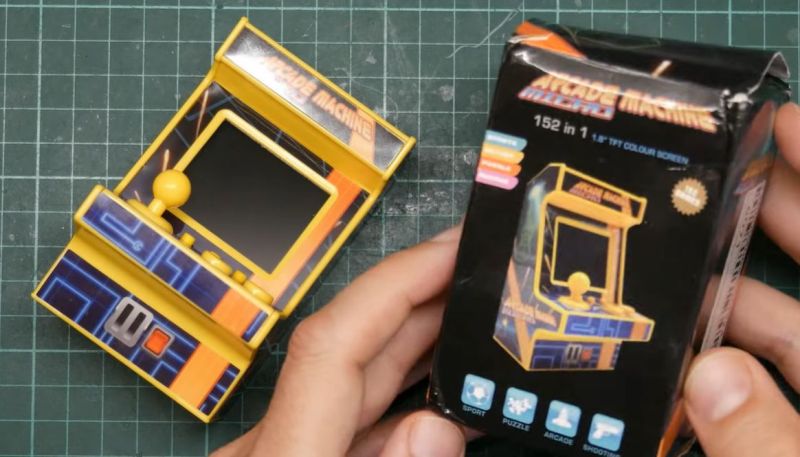
For some reason, people are really into tiny arcade machines that basically require you to ruin your hands and eyes in order to play on them. That said, unlike the fifty gazillion ‘retro consoles’ that you can buy everywhere, the particular mini arcade machine that [David Given] of [Poking Technology] obtained from AliExpress for a teardown and ROM dump seems to have custom games rather than the typical gaggle of NES games and fifty ROM hack variations of each.
After a bit of gameplay to demonstrate the various games on the very tiny machine with tiny controls and a tiny 1.8″, 160×128 ST7735 LC display, the device was disassembled. Inside is a fairly decent speaker, the IO board for the controls, and the mainboard with an epoxy blob-covered chip and the SPI EEPROM containing the software. Dumping this XOR ‘encrypted’ ROM was straightforward, revealing it to be a 4 MB, W23X32-compatible EEPROM.
Further reverse-engineering showed the CPU to be a WDT65C02-compatible chip, running at 8 MHz with 2 kB of SRAM and 8 kB of fast ROM in addition to a 24 MHz link to the SPI EEPROM, which is used heavily during rendering. [David] created a basic SDK for those who feel like writing their own software for this mini arcade system. Considering the market that these mini arcade systems exist in, you’ve got to give the manufacturer credit for creating a somewhat original take, with hardware that is relatively easy to mod and reprogram.
Thanks to [Clint Jay] for the tip.
















Using the joystick obfuscates 10-20% of the screen ? this begs for a casemod, with a plastic Fresnel lens magnifying the screen (who cares about view angle on such a thing?)
In the video, that’s because I had to put the screen at right angles to the camera to get it all in focus. In real life it’s better as you tend to look down on it, not straight at the screen. But I suspect the real answer is that no actual industrial design went into this thing.
Hopefully [David Given] would be willing to share the firmware with the MAME team. It’s all but guaranteed that MAME already emulates, in whole or in part, the particular SoC used on this machine. In fact, I wouldn’t be at all surprised if the firmware already slots into one of the couple-dozen drivers for various handheld/TV plug-in systems based on different 6502-derived SoCs.
Since MAME became the go-to emulator for LCD handhelds and TV plug-in games, it’s become pretty staggering A) just how many different units there were, and B) just how many of them actually were released with entirely original games.
The most likely candidates are some form of XaviX or Elan, which were popular 65(C)02 derivatives used in a bunch of cheap Chinesium mini-machines.
For my money, though, I’m consistently impressed at how much life was able to be wrung out of the SunPlus SPG24x and SunPlus SPG26x series of microcontrollers. Those things had on-board graphics and audio that were very roughly akin to the SNES, capability-wise, had a 16-bit architecture in every sense of the term (no byte addressing, everything is in 16-bit-word units!), yet only had around 3 kilobytes of work RAM. Some later models could even push a full 680×480, though the interlace flicker was pretty agonizing. They’re probably best known for the (rightfully) maligned Wii knockoff – the Chintendo/JungleSoft “Vii” – but they also provided the brains behind a ton of TV plug-in games from the 2000’s, featuring licensed IP and developed by legit companies like Digital Eclipse and Jakks Pacific.
That’s fascinating. How do you know so much about this topic? Is there a website for it?
So, a commenter pointed me towards the Game King, which is a similar but simpler device, and from there I found this page: https://bootleggames.fandom.com/wiki/%221.8%22_Handheld_Games and from there I found that there is, indeed, MAME support for this series of devices: https://github.com/mamedev/mame/blob/master/src/mame/tvgames/st2302u_bbl_spi.cpp
But it doesn’t look like it actually functions; it looks like the skeleton only. I’ve tried to contact the author. They’re welcome to use anything I figured out. I did check the two ROM images I produced (which are illegally checked into the github repository) and the checksums don’t match anything that MAME references.
Re the manufacturer: I did find a GeneralPlus datasheet of a device which closely matches the layout of what I’m seeing; I/O ports at 0000.007f, RAM from 0080 up, ROM at 6000, probably a 6502 (GeneralPlus are very careful not to namecheck the 6502 anywhere, although some datasheets do describe the instruction set in enough detail to be sure that’s what it is). But that device, a remote control controller, has much less RAM, so it’s clearly not the same one. I didn’t know about XaviX or Elan. If you know any way to identify the chipset, I’d love to know.
Re the µnSP: that instruction set is wonderfully cursed. I’d love to do something with it one day.
Honestly, I wouldn’t be surprised if it was a VT02 chip in there. Most “NES clones with LCD” here are VT02 based. :)
https://www.nesdev.org/wiki/VTxx
There’s also a tool made by Tim Schuerewegen called NESMaker. It can make a multi-rom image for a bunch of devices. :)
https://forums.nesdev.org/viewtopic.php?t=19581
Nah, it’s not a NOAC — video rendering is done in software, compositing one scanline at a time and then updating the ST7735’s external video memory. Sprite data is streamed from SPI flash on demand. It’s a completely different architecture.
David: I suspect the dev is Tony Jih https://github.com/tonyjih
He was working for Anbernic for a while and his forks of OpenDingux on the RG300X and RG350 are referred to as the “Tony System” in sales blurbs.
Nope – I asked and he said it wasn’t him :)
Either my Ali-fu is lacking, or they’re cheaper on Amazon! (£18 vs £22).
Excellent video btw. Very long, but content-packed.
https://aliexpress.com/item/32950683000.html
same model, different stickers
I’ve found something which looks like these here in Switzerland for 9 CHF (https://www.action.com/de-ch/p/3205536/retro-mini-arcadeautomat/). Don’t know what delivery to the UK would be.
Both of those are 200 games, 2.5″ screen. How can I tell whether they’re this or not?
Sadly, they’re not exactly well labelled. AFAIK the things to look for are: screenshots (some will show the menu or title screens with very characteristic gold letters), two buttons rather than four, and no AV out. The latter usually means it’s a NOAC. But all I can do is wish you luck.
Those are VT02 ones for sure. (I buy them at Action all the time lol)
They’re even listed on the NESDev thread (last page) https://forums.nesdev.org/viewtopic.php?t=19581